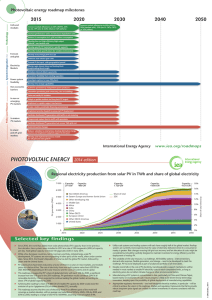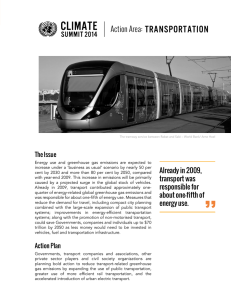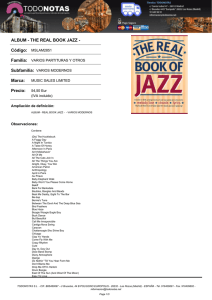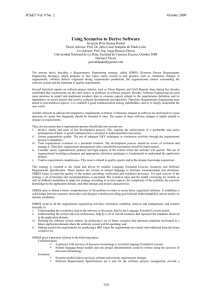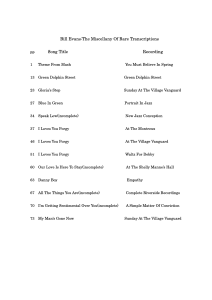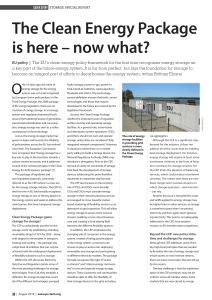World-Energy-Scenarios Composing-energy-futures-to-2050 Executive-summary
Anuncio
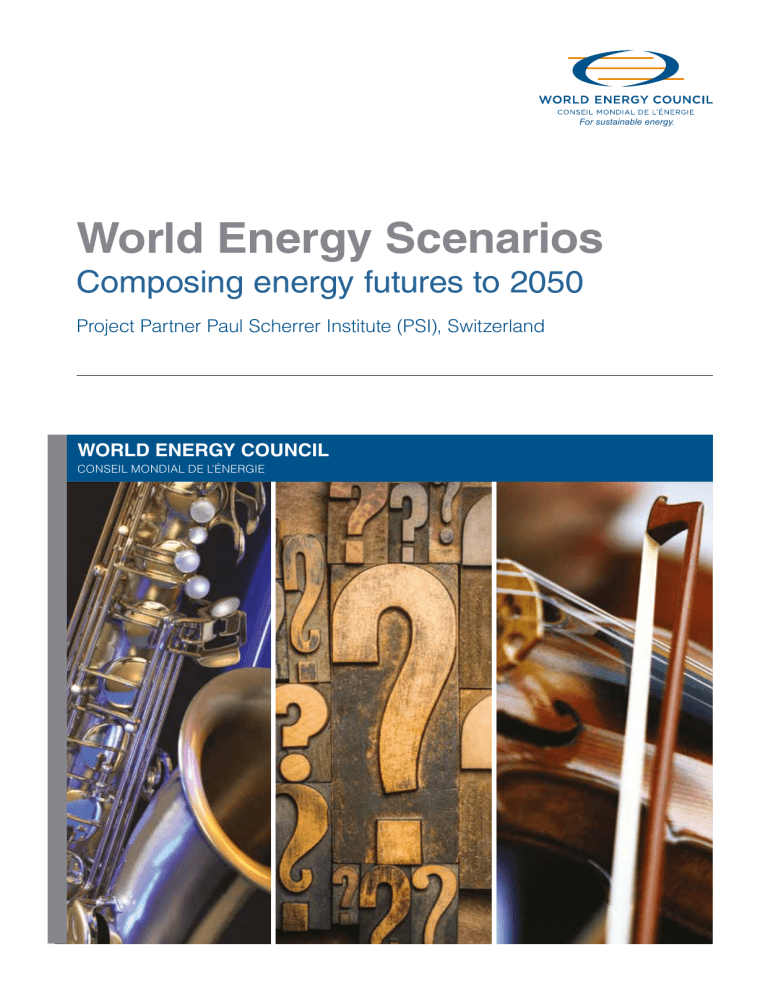
For sustainable energy. World Energy Scenarios Composing energy futures to 2050 Project Partner Paul Scherrer Institute (PSI), Switzerland WORLD ENERGY COUNCIL CONSEIL MONDIAL DE L’ÉNERGIE Officers of the World Energy Council Pierre Gadonneix Chairman Marie-Jose Nadeau Chair-elect Younghoon David Kim Co-chair elect Leonhard Birnbaum Vice Chair Europe Hwan-eik Cho Vice Chair 2013 Congress, Daegu Arup Roy Choudhury Vice Chair Asia Pacific/South Asia José da Costa Carvalho Neto Chair Programme Committee Jean-Marie Dauger Chair Communications & Outreach Committee Kevin Meyers Vice Chair North America Abubakar Sambo Vice Chair Africa Brian A. Statham Chair Studies Committee José Antonio Vargas Lleras Vice Chair Latin America/Caribbean Graham Ward, CBE Vice Chair Finance Wu Xinxiong Vice Chair Asia Taha M. Zatari Vice Chair Special Responsibility Gulf States & Middle East Christoph Frei Secretary General World Energy Scenarios World Energy Council’s unique approach to composing energy futures to 2050 The WEC’s approach Scenarios are alternative views of the future which can be used to explore the implications of different sets of assumptions and to determine the degree of robustness of possible future developments. While most widely known scenarios are normative, the WEC has adopted a different, exploratory approach. ‘Normative’ in this context means that the scenarios are being used to drive the world towards a specific objective such as a particular atmospheric CO2 level. In contrast, the WEC with its exploratory scenarios Jazz and Symphony, attempts to provide decision makers with a neutral fact-based tool that they will be able to use to measure the potential impact of their choices in the future. Rather than telling policymakers and senior energy leaders what to do, in order to achieve a specific policy goal, the WEC’s World Energy Scenarios to 2050 will allow them to test the key assumptions that they decide to make to shape the energy of tomorrow. Investors can use this tool to assess which are likely to be the most dynamic areas and real game-changers of tomorrow. Assessing the energy trilemma These scenarios are designed to help a range of stakeholders address the ‘energy trilemma’ of achieving environmental sustainability, energy security, and energy equity and hence putting forward different policy options. Clearly, each policy option has some cost associated with it. The cost of one scenario versus the other must not only be considered in terms of necessary capital investments and the impact on and of gross domestic product (GDP) growth; the overall environmental benefits and avoided climate change adaptation costs also need to be taken into account. This means that one scenario is not necessarily better than the other and should not be judged as such. Instead, a wider view needs to be adopted when assessing the overall implications of each of the scenarios. These scenarios are therefore likely to change the way energy decision makers consider the choices they make in understanding the real impact of their actions in the long term. This approach can only be done successfully by a network like the WEC’s with its impartial and inclusive membership structure. Over 60 experts from more than 28 countries have contributed to the WEC’s scenario building process over a period of three years. ENERGY EQUITY ENVIRONMENTAL SUSTAINABILITY World Energy Council 2013 1 World Energy Scenarios 10 key messages 1 Energy system complexity will increase by 2050. 2 Energy efficiency is crucial in dealing with demand outstripping supply. 3 The energy mix in 2050 will mainly be fossil based. 4 Regional priorities differ: there is no ‘one-size-fits-all’ solution to the energy trilemma. 5 The global economy will be challenged to meet the 450ppm target without unacceptable carbon prices. 6 A low-carbon future is not only linked to renewables: carbon capture, utilisation and storage (CC(U)S) is important and consumer behaviour needs changing. 7 CC(U)S technology, solar energy and energy storage are the key uncertainties up to 2050. 8 Balancing the energy trilemma means making difficult choices. 9 Functioning energy markets require investments and regional integration to deliver benefits to all consumers. 10 2 Energy policy should ensure that energy and carbon markets deliver. World Energy Scenarios Composing Energy Futures to 2050 The WEC has built two scenarios typified by characteristics, which, each from their own perspective, may comprehensively describe large parts of the world in 2050. In this scenario exercise, the elements of the two scenarios are generalised as being applicable to the (albeit imaginary) whole world: the more consumerdriven Jazz scenario and the more voter-driven Symphony scenario. While the scenarios are ‘music based’, they are completely different in nature. JAZZ SYMPHONY As an energy scenario, Jazz has a focus on energy equity with priority given to achieving individual access and affordability of energy through economic growth. As an energy scenario, Symphony has a focus on achieving environmental sustainability through internationally coordinated policies and practices. Jazz is a style of music, characterised by a strong but flexible rhythmic structure with solo and ensemble improvisations on basic tunes and chord patterns. In Jazz, musicians have freedom to take the lead and improvise; others in the band will often follow. A Symphony is a complex piece of music with a fixed structure composed to be played by a symphony orchestra. The orchestra will have a conductor and 80 or so orchestra members will each have a specific role to play and score to follow. World Energy Council 2013 3 The WEC’s scenarios at a glance The stories behind Jazz and Symphony JAZZ World where there is a consumer focus on achieving energy access, affordability, and quality of supply with the use of best available energy sources. SYMPHONY World where there is a voter consensus on driving environmental sustainability and energy security through corresponding practices and policies. JAZZ SYMPHONY In the absence of international agreed commitments carbon market grows more slowly from bottom up based on regional, national and local initiatives. Carbon market is top down based on an international agreement, with commitments and allocations. Higher GDP growth Free-trade strategies lead to increased exports. Renewable and low-carbon energy grows in line with market selection. Energy sources compete on basis of price and availability. 4 World Energy Scenarios Source: World Energy Council (2013) Nationalistic strategies result in reduced exports/ imports. Lower GDP growth Due to faster convergence across countries, higher international competition, and low environmental constraints. Due to less convergence, more environmental constraints and a more capital-intensive growth pathway. Certain types of renewable and low-carbon energy actively promoted by governments. Selected energy sources are subsidised and incentivised by governments. Main players are multi-national companies, banks, venture capitalists, and price-conscious consumers. Technologies are chosen in competitive markets. Main players are governments, public sector and private companies, NGOs, and environmentallyminded voters. Governments pick technology winners. The WEC’s scenarios findings Composing energy futures Energy landscape in 2050 The energy landscape we expect to see in 2050 will be quite different from how it looks today. Meeting future energy demand will be a key challenge. The world’s population will increase from approximately 7 billion in 2013 to approximately 8.7 billion in the Jazz scenario and approximately 9.4 billion in the Symphony scenario in 2050, which is equal to a 26% increase (36% respectively). The GDP per capita will also increase from slightly more than 9,000 US$2010 on average globally (US$2010 MER) in 2010 to approximately 23,000 US$2010 in Jazz and about 18,000 US$2010 in Symphony in 2050. This represents an increase by 153% and 100%, respectively. Mobility will also increase, with car ownership in terms of cars per 1000 people increasing from 124 in 2010 to 244 in 2050 in Jazz and 193 in Symphony. This equates to an increase by 98% and 57% respectively. The WEC’s view on global economic growth up to 2050 Source: World Energy Council (2013) GDP growth, compound annual growth rate (CAGR) % market exchange rate (MER) (%PPP) 1990–2000 JAZZ SYMPHONY 2.9 (3.2) 2000–2010 2.8 (3.5) 2010–2020 2020–2030 2030–2040 2040–2050 3.2 (3.9) 3.1 (3.8) 2.9 (3.5) 2.6 (3.1) 2.8 (3.3) 2.6 (3.2) 2.5 (3.0) 2.2 (2.7) ‘This is a time of unprecedented uncertainty for the energy sector. Energy demand will continue to increase. The pressure and challenge to develop and transform the energy system is immense.’ World Energy Council 2013 5 What Jazz and Symphony can offer Many key messages arise from the Jazz and Symphony scenarios. One of these is that more international cooperation, including internationally harmonised politics and trust in market mechanisms, is essential for achieving environmental goals, energy security and energy equity. Jazz and Symphony can contribute towards enhancing the debate on how these goals can best be achieved, taking into account a wide range of policy options. The WEC’s World Energy Scenarios to 2050 will help strengthen the debate on how collaboration among all relevant stakeholders in the energy field can effectively be implemented. ‘Neither scenario relies on a “magic wand” to radically change the future. Rather, both scenarios are exploratory and show the multiplicity of possible choices regarding the energy trilemma.’ 6 World Energy Scenarios From stories to figures The WEC’s scenario story quantification assumptions The WEC’s scenario stories were quantified into the following figures which acted as constraints in the two models. JAZZ 2050 SYMPHONY 2050 JAZZ 2050 GDP growth (CAGR, PPP) 3.54% SYMPHONY 2050 Climate policy 3.06% Limited (and more diverse) Stronger (with global convergance) Resources Population (billion) 9.3 8.7 More expensive unconventionals (less competition, regulation, water) Better access to unconventional resources (esp. gas) Technology innovation Technology support Further development of CCGT, decentralised power (SPV), wind, gas vehicles, EVs Focused R&D programmes, esp. CC(U)S demonstration, nuclear, solar photo voltaic (SPV) Efficiency Limited; energy choice based on free markets – only limited nuclear, CC(U)S, large hydro Source: World Energy Council (2013) Government support for nuclear, large hydro, CC(U)S and renewables Increasing Increasing more strongly World Energy Council 2013 7 Key message Energy system complexity will increase by 2050. Total primary energy supply The WEC estimates that total primary energy supply (equal to consumption) will increase globally from 546 EJ (152 PWh) in 2010 to 879 EJ (144 PWh) in the Jazz scenario and 696 EJ (193 PWh) in the Symphony scenario in 2050. This corresponds to an increase of 61% in Jazz and 27% in Symphony. Just to compare: from 1990 to 2010 – which is roughly half the time span covered in this scenario study – total global primary energy consumption rose by approximately 45%. It is expected that global primary energy consumption will continue to rise, but at a much lower rate than in previous decades. Meeting both global and regional energy demand will be a challenge. There is no one global solution to the energy supply issue. Instead, each of the individual parts of the challenge must be worked out to reach the global goal of sustainable, affordable and secure energy supply for all. +61% +27% in the Jazz scenario in 2050 in the Symphony scenario in 2050 Estimated increase globally of total primary energy supply (equal to consumption) 8 World Energy Scenarios Share of net imports in primary energy supply (%) (for aggregated world regions) 21.5 20.5 in 2010 19.2 Jazz 2050 Symphony 2050 Source: World Energy Council Note: The share of net imports in primary energy supply is defined as the sum of net imports of those aggregated world regions which are net importers, divided by the total global primary energy supply. Total primary energy supply by region (Units: EJ/y) 2010 Jazz 2050 Symphony 2050 North America 116 130 105 Europe South and Central Asia 121 135 114 43 136 96 145 211 164 East Asia MENA 37 79 67 LAC 29 67 51 Africa 23 50 46 South and Central Asia and East Asia are the centres of future growth, in particular China and India. Other regions grow too but from a lower base. Southeast Asia and Pacific 32 71 54 World Energy Council 2013 9 Key message Energy efficiency is crucial in dealing with demand outstripping supply. Energy efficiency Energy efficiency will increase significantly in both scenarios: primary energy intensity as measured in energy use per unit of GDP created will decrease by 50% and 53% in Jazz and Symphony respectively by 2050. Hence when comparing primary energy consumption to GDP produced, only half the amount of energy is needed until 2050 to produce the same output. This is true for both scenarios although primary energy consumption is higher in 2050 in the Jazz scenario than it is in the Symphony scenario. WEC World Energy Scenarios to 2050 show that energy efficiency and energy conservation are absolutely crucial in dealing with demand outstripping supply – both require a change in consumer priorities and have cost implications across industries – and hence capital is required to finance energyefficiency measures in terms of an initial investment before it can pay off. Energy intensity will change by -50% -53% in the Jazz scenario by 2050 10 World Energy Scenarios in the Symphony scenario by 2050 Primary energy intensity (MJ/USD2010 MER) 8.6 4.4 in 2010 Jazz 2050 4.1 Symphony 2050 Source: World Energy Council (2013) World Energy Council 2013 11 Key message The energy mix in 2050 will mainly be fossil based. Future primary energy mix The future primary energy mix in 2050 shows that growth rates will be highest for renewable energy sources. In absolute terms, fossil fuels (coal, oil, gas) will remain dominant, up to and including 2050. The share of fossil fuels will be 77% in the Jazz scenario and 59% in the Symphony scenario – compared to 79% in 2010. The share of renewable energy sources will increase from around 15% in 2010 to almost 20% in Jazz in 2050 and almost 30% in Symphony in 2050. Nuclear energy will contribute approximately 4% of total primary energy supply in Jazz in 2050 and 11% in Symphony globally – compared to 6% in 2010. Fossil fuels will remain dominant up to 2050 (share of fossil fuels) 79% in 2010 12 World Energy Scenarios 77% Jazz 2050 59% Symphony 2050 Total Primary Energy Supply (Units: EJ/y) Source: World Energy Council (2013) 879 In the Jazz scenario future development will depend on fossil fuels whereas in Symphony development will be fuelled by renewables. 696 546 in 2010 Jazz 2050 Symphony 2050 World Energy Council 2013 13 Global electricity generation will increase between 123% and 150% by 2050. Global electricity generation Global electricity generation will increase between now and 2050: In 2010, global electricity production was 21.5 billion MWh globally. In Jazz, this is expected to increase by 150% to 53.6 billion MWh by 2050. In Symphony, the increase is about 123% to 47.9 billion MWh by 2050. Simply due to the sheer increase in electricity production that is needed to meet future demand, the future electricity generation mix will be subject to tremendous changes up to 2050. Global electricity generation (billion MWh) Source: World Energy Council 53.6 47.9 21.5 in 2010 14 World Energy Scenarios Jazz 2050 Symphony 2050 Electricity production by fuel type Geothermal Hydro Solar Hydrogen Oil Coal Wind Biomass (with CCS) Nuclear Gas Biomass Gas (with CCS) Coal (with CCS) JAZZ 60,000 SYMPHONY 50,000 Technologies that will have the biggest impact are Solar and CCS. TWh/y 40,000 30,000 Technologies that will have the biggest impact are highly efficient CCGT plants and coal-fired power plants. 20,000 10,000 0 2010 2050 2050 World Energy Council 2013 15 Investment needs in electricity generation will be between $19 trillion and $26 trillion worldwide up to 2050. Future investment needs in electricity generation Huge investment in electricity generation is needed to meet future electricity demand. The WEC estimates that total investment needed will range from US$19 trillion in Jazz to US$26 trillion in Symphony (in 2010 terms) – in terms of cumulative investment in electricity generation in both scenarios (2010–2050, undiscounted). Depending on each scenario, a share of 46% in Jazz and almost 70% in Symphony of this is to be invested in renewable electricity generation. Major investment requirements are in solar PV, hydro and wind electricity generation capacity. The WEC’s work clearly highlights that the availability of funds for investment is one of the key clusters in scenario building terms that will shape the energy landscape until 2050. Share of investment in renewable electricity generation 46% in the Jazz scenario by 2050 16 World Energy Scenarios 70% in the Symphony scenario by 2050 Investment requirements in electricity generation (2010 –2050, billion US$2010, undiscounted) JAZZ 2050 SYMPHONY 2050 Source: World Energy Council (2013) $19,310 $25,720 TOTAL $6,950 $1,660 $1,620 $200 $90 Coal (with CC(U)S) Coal $490 $140 $90 $1,980 $2,050 Gas (with CC(U)S) Oil $2,020 $1,010 Nuclear Gas $9,660 $3,280 $2,720 $2,950 $340 $1,950 Hydropower Solar Wind $260 $240 $440 $520 $720 $30 CO2 Biomass $3,520 Biomass (with CC(U)S) Geothermal $100 Hydrogen World Energy Council 2013 17 The overall degree of energy access will increase. Africa faces great challenges to increase access to electricity. Access to energy The degree of electrification measured in terms of the share of electric energy on the final energy mix, increases up to 2050 significantly. In Jazz, the degree of electrification will be almost 30% in 2050, in Symphony this will even be slightly more than 30% in 2050 – as compared to 17% in 2010. Electricity consumption per capita increases globally by 111% in Jazz and 78% in Symphony in 2050. Electricity access, measured as the share of population connected to the electricity grid will increase in both scenarios: energy access will hence improve.1 While in 2010, 1.267 billion people were without access to electricity globally, this reduces to 319 million in Jazz and 530 million in the Symphony scenario in 2050. Electrification (in terms of the share of electricity in final energy consumption) (%) 27 32 17 in 2010 Jazz 2050 Symphony 2050 Source: World Energy Council (2013) 1 The estimate of 1.267 billion people without access to electricity for 2010 differs from that of the World Bank of 1.2 billion people due to ‘differences in a relatively small number of countries, including Pakistan, Indonesia, South Africa, Thailand, and Gabon, where the International Energy Agency (IEA) uses government data (which typically report more people without access) while the World Bank uses estimates derived from various types of surveys’. (World Bank, 2013). 18 World Energy Scenarios 1,267 Population without access to electricity (in millions) Source: IEA 2000, 2002, 2004, 2006, 2007, 2009, 2010, 2011, 2012 (historical data) Source: World Energy Council (2013) 2010 JAZZ 2050 SYMPHONY 2050 589 530 471 402 319 266 0 0 45 South & Central Asia 0 Middle East & North Africa 0 20 Sub-Saharan Africa 29 Latin America & The Caribbean Southeast Asia & Pacific 8 26 102 22 0 East Asia 135 0 World Access to electricity will improve all over the world. Sub-Saharan Africa will struggle having the least. World Energy Council 2013 19 Key message Regional priorities differ: there is no ‘one-sizefits-all’ solution to the energy trilemma. Regional developments Future economic growth shifts from developed countries to developing and transition economies, in particular in Asia. Of all the eight regions considered in this scenario study, Asia will be characterised by highest economic growth both in relative and absolute terms. By 2050, nearly half of all economic growth (measured in terms of production of GDP) will happen in Asia and its three sub-regions: Central and South Asia, East Asia and Southeast Asia and Pacific both for Jazz and Symphony. This means that the share of Asia on total primary energy consumption will increase from 40% in 2010 to 48% in Jazz and 45% in Symphony. To compare: by 2050, Europe and North America (including Mexico) will make up for about 30% of total global primary energy consumption in Jazz and 31% in Symphony (2010: 44%). Africa, including the middle East will account for 15% (Jazz) and 16% in Symphony (2010: 11%) and Latin America and The Caribbean 8% in Jazz and 7% in Symphony (2010: 5%). GDP per capita (US$2010 MER) $9,160 in 2010 Source: World Energy Council 20 World Energy Scenarios $23,140 Jazz 2050 $18,320 Symphony 2050 201 GDP by region (trillion US$2010 MER) 172 Source: World Energy Council (2013) 2010 JAZZ 2050 SYMPHONY 2050 63 20 3 27 17 14 2 20 35 13 East Asia 11 10 Southeast Asia & Pacific 3 Europe North America Latin America & The Caribbean 1 12 11 Middle East & North Africa 17 Sub-Saharan Africa 18 15 4 42 35 South & Central Asia 40 36 33 World Growth is prominent in all regions, Asia will boom in terms of the scale of its economic development. World Energy Council 2013 21 Key message The global economy will be challenged to meet the 450ppm target without unacceptable carbon prices. Implications for climate The WEC has analysed where the Jazz and Symphony scenarios might lead in terms of climate change. The WEC has also assessed the potential impact of Jazz and Symphony scenarios on the climate with reference to the work of the Intergovernmental Panel on Climate Change (IPCC). Jazz scenario In Jazz, an assumption is made that the negotiations on climate change and emissions targets are not finalised. In the absence of international agreed commitments, regions, countries, states and municipalities take their own sustainable development initiatives and pathways. An international carbon market grows slowly from the bottom up based on regional, national and local initiatives, which coalesce to achieve greater market efficiencies and liquidity. Commercially viable innovative low-carbon technologies (solar, wind, and city gas/waste to energy) experience growth, major reductions in CO2 emissions come from growth in natural gas, in preference to oil and coal for purely economic reasons. Symphony scenario In Symphony, countries pass through the Doha Gateway and successfully negotiate a global treaty because all countries are prepared to accept commitments and concessions. Climate change has more focus along with international initiatives on climate change. Low-carbon technologies are promoted despite lacking commercial viability at initial stages. The carbon market is top-down based on an international agreement, with commitments The WEC’s commitment to climate change At the COP 15 (Conference of Parties) meeting, the 15th session of the United Nations (UN) Framework Convention on Climate Change, the ‘Copenhagen Agreement’ or ‘Copenhagen Accord’ was ratified by delegates and they endorsed the continuation of the Kyoto Protocol. Specific emissions-reduction targets for 2020 were submitted by individual countries. At subsequent COP meetings, this was reinforced, in particular at the COP18 meeting in Doha when the ‘Doha Climate Gateway’ was developed – a package of deals that set out a work programme through which both rich and developing countries can deliver a new international climate agreement. The Doha Climate Gateway includes a timetable for a 2015 global climate change agreement and for increasing ambitions before 2020. At Doha, 22 World Energy Scenarios countries agreed a course for negotiating the Durban Platform for Enhanced Action, a new climate deal for all countries to be agreed by 2015 and to take effect in 2020 – the Ad Hoc Working Group on the Durban Platform for Enhanced Action (ADP). To establish a clear link between energy use and climate change objectives, the WEC has included the Doha Climate Gateway as a key differentiator between its two scenarios. The WEC assumes that in the Symphony scenario, countries pass through the Gateway and successfully negotiate a global treaty. In the Jazz scenario, these negotiations fail, and regions, countries, states and municipalities take their own sustainable development pathways. Emissions trajectories for atmospheric GHG concentrations Source: World Energy Council (2013) based on the IPCC’s 4th assessment report (AR4) (2007) 80 CO2 emissions (Gt/y) 70 60 50 40 30 20 10 0 2010 2020 2030 2040 IPCC Categories (CO2 – eq) 445−490 ppm 535−590 ppm 710−855 ppm JAZZ 490−535 ppm 590−710 ppm 855−1130 ppm SYMPHONY 2050 Note: assumes over the long term that non-energy CO2 emissions from industry,agriculture and land use are reduced to insignificant levels in Jazz and Symphony JAZZ SYMPHONY CO2 emissions in the Jazz scenario follow a trajectory consistent with a long-term atmospheric concentration of all GHGs of between 590 and 710 parts per million CO2 equivalent. Symphony is on track for 490-535 ppm CO2 equivalent. and allocations. In the early part of the scenario period, national initiatives to meet treaty obligations to reduce emissions emerge (developed and developing countries). These national initiatives are linked to form regional markets with exchange of Clean Development Mechanism (CDM) and other emission units. The final part of the scenario period sees global action on climate change with the market instrument emission trading as the leading mechanism for meeting CO2 emission obligations. The WEC’s scenarios and climate implications The above chart shows the potential implications of the emissions trajectories for Jazz and Symphony for atmospheric GHG concentrations (and hence climate) based on the IPCC’s 4th Assessment Report: Although Jazz includes a stronger emphasis on adaptation and Symphony mitigation, in both scenarios additional action is expected over the longer term (beyond 2050), further reducing the impact on climate. The implications of these changes to atmospheric GHG concentrations for surface temperature change, sea-level rise, changes in precipitation, incidence of extreme events and other impacts remain uncertain. Pressure for climate action will change over the period, the WEC recognises that the climate forcing of CO2 is considered now to be lower in some of the scientific literature in 2013. There is also increasing awareness of severe weather events that could be linked to climate forcing. World Energy Council 2013 23 Key message A low-carbon future is not only linked to renewables: CC(U)S is important and consumer behaviour needs changing. CO2 emissions and climate change CO2 emissions will increase in both scenarios in the first half of the scenario period. In the Symphony scenario, where, by assumption, greater emphasis is placed on climate change mitigation and adaptation, a turning point will be reached by 2020. In the Jazz scenario, the turning point is only reached by 2040. As far as the total amount of CO2 emissions are concerned, both scenarios differ substantially. In the Jazz scenario, CO2 emissions will be more than 44 billion tonnes per annum in 2050 which is 45% higher than in 2010. In the Symphony scenario, CO2 emissions reach 19 billion tonnes per annum which is nearly 40% lower than in 2010. The WEC’s World Energy Scenarios to 2050 underline that a reduction of greenhouse gas emissions is possible in the second half of the scenario period with global agreements and the implementation of cost-efficient measures like emissions trading within a cap and trade system (assumed in Symphony). 24 World Energy Scenarios CO2 emissions (Gt CO2/y) 44.1 30.5 in 2010 Jazz 2050 19.1 Symphony 2050 Source: World Energy Council (2013) (CO2 emissions only, not CO2 equivalents) World Energy Council 2013 25 Share of renewables in electricity generation will be between 31% and 48% by 2050. Towards low-carbon electricity generation Electricity generation from renewable energy sources (RES-E) will increase around four to five times by 2050 in comparison to 2010. This is strongest in the Symphony scenario. In Symphony, electricity generation from hydro doubles, for biomass the increase is eight-fold, and for wind eleven-fold when comparing figures for 2010 with 2050. Solar PV has the highest increase of approximately 230 times between 2010 and 2050. By 2050, globally, almost as much electricity is produced from solar PV as from coal (coal and coal with CC(U)S). The share of renewable energy sources for electricity generation will increase from approximately 20 per cent in 2010 to more than 30% in 2050 in Jazz and nearly 50% in Symphony. The degree to which renewable energy sources will be used and investment in CC(U)S technologies for coal and gas (and also biomass) will be decisive in mitigating climate change. 26 World Energy Scenarios Solar power will increase from 34.4 (TWh/y) to 2,980 7,740 in the Jazz scenario by 2050 in the Symphony scenario by 2050 Renewable Electricity Production (Units: TWh/y) Source: World Energy Council (2013) Hydro 3,490 Geothermal 5,790 in 2010 7,700 Jazz 2050 in 2010 4,510 Jazz 2050 950 in 2010 Jazz 2050 4,000 Symphony 2050 35 in 2010 Biomass 2,980 7,740 Jazz 2050 Symphony 2050 Biomass (with CCS) CO2 340 in 2010 650 Symphony 2050 Solar Wind 360 70 Symphony 2050 1,920 Jazz 2050 1,910 Symphony 2050 0 in 2010 440 Jazz 2050 CO2 800 Symphony 2050 World Energy Council 2013 27 Key message CC(U)S technology, solar energy and energy storage are the key uncertainties up to 2050. Carbon capture, utilisation and storage Carbon capture utilisation and storage (CC(U)S) technologies are widely employed in Symphony and hence subject to higher growth rates in the Symphony scenario than in the Jazz scenario. Half of the total electricity generated based on fossil fuels will be in conjunction with CC(U)S in 2050 in Symphony. Combining nuclear and CC(U)S for gas, coal and biomass, more than 80% of all electricity generated in 2050 will be from low-carbon sources in the Symphony scenario, compared to 40% in the Jazz scenario. To compare: In 2010, only one-third of global electricity generation was CO2 from low-carbon sources. The WEC believes that CC(U)S technology, solar energy and energy storage are the key uncertainties moving forward up to 2050. For CC(U)S to work, clear legislative frameworks are needed – combined with infrastructure investment and the right incentives. A low-carbon future is not only linked to renewables: CC(U)S is important and consumer behaviour needs changing. Changes in consumption habits can be an effective way to decarbonise the energy system. Voters need to balance local and global issues. ‘For decarbonisation to be more effective, citizens play a crucial role, as consumers in Jazz, and voters in Symphony.’ 28 World Energy Scenarios Carbon capture, utilisation and storage CO2 capture and separation plant CO2 compression unit CO2 injection CO2 transport CO2 injection Enhanced Oil Recovery CO2 source (e.g. power plant) CO2 storage Oil CC(U)S (Units: GtCO2/y) CC(U)S will boom in East Asia, as the future growth centre. Environmental issues become a concern and governments will react. Source: World Energy Council (2013) Jazz 2050 Symphony 2050 North America 0.2 1.1 Europe South and Central Asia 0.3 1.2 0.1 1.2 0.2 1.6 East Asia MENA 0.1 0.4 LAC 0.1 0.2 Africa 0.1 0.5 Southeast Asia and Pacific 0.2 0.7 World Energy Council 2013 29 Assessment of Jazz vs. Symphony The WEC believes that a balanced trilemma can only be achieved through compromises and global initiatives. Together with energy efficiency, CC(U)S, solar and wind will be the key technologies driving change forward. Key messages Energy security: Balancing the energy trilemma means making difficult choices. Energy equity: Functioning energy markets require investments and regional integration to deliver benefits to all consumers. Environmental sustainability: Energy policy should ensure that energy and carbon markets deliver. 30 World Energy Scenarios JAZZ • Higher energy production • Greater trading and diversity of international fossil energy suppliers ENERGY EQUITY SYMPHONY • Wider diversity of energy resource types • Has government-promoted investment in infrastructure ENVIRONMENTAL SUSTAINABILITY JAZZ JAZZ • On average, energy equity progresses better • More people are able to afford more energy because the global market leads to higher GDP growth • Emissions don’t drop until after 2040 • Performance improves markedly if a bottom-up carbon market develops early in the scenario, but the higher GDP growth still means higher emissions • Puts more emphasis on adaptation SYMPHONY • Energy equity is less because there are inevitably interventions restricting GDP growth • Funds directed into low-carbon initiatives would actually start diverting funds from other government priorities such as health care and other programmes • Financial resources are not limitless • Governments have to set spending priorities • Wise choice of policies as identified in the WEC World Energy Trilemma Report could avoid this drop, as countries strive to score well on the WEC’s trilemma index SYMPHONY • Scores well on environmental impact mitigation particularly CO2 emission reduction, with emissions dropping after 2020 • Externalities are more effectively internalised: this is primarily because countries adopt a range of mechanisms to meet treaty obligations on CO2 • Higher carbon prices would achieve higher emission reduction • The market instrument emission trading is assumed as the leading mechanism for meeting CO2 emission obligations in the second part of the scenario period World Energy Council 2013 31 The WEC’s scenario building methodology The WEC’s World Energy Scenarios to 2050 are designed to glimpse what the future might look like in a plausible and maybe challenging manner – yet they are not meant to be exact or precise forecasts. Predicting the future is not possible. As we move on, the range of possible future outcomes becomes greater – especially since uncertainty increases. As trends and innovations pick up speed and gain momentum, their impact increases. The signals we observe today can be distilled into drivers, critical uncertainties, and predetermined elements that form the future. It is of strategic importance that governments and companies who seek to make investments and take decisions in the energy sector undertake some sort of long-term planning exercise. In order to aid senior decision makers and policymakers in this endeavour the WEC began its newest scenario building exercise in 2010. To develop a view of how the energy landscape might look in 2050, the WEC started by looking at the critical drivers of the energy system from the broadest possible viewpoint by adopting a systemic approach. The WEC structured its analysis by first identifying 116 drivers that will affect the energy landscape globally up to 2050. These drivers were narrowed down to 29 key issues that will have an impact on the energy landscape up to 2050, and 15 key clusters where identified that were then used to derive the two future spaces or scenarios. The scenario funnel: As uncertainty increases, the funnel widens Ran Uncertainty Source: World Energy Council (2013) o ge f po es World Energy Scenarios om 32 utc e Extrem le o E tion ola p xtra Today 2050 ssib me t re x E rio na e Sc Scenario Time The WEC’s scenarios: Two future spaces Source: World Energy Council (2013) 29 Issue papers 116 drivers Scenario 1 (Jazz) 15 clusters Regional messages Scenario 2 (Symphony) Expert input These 15 key clusters are: 1. 2. 3. 4. 5. 6. 7. 8. 9. 10. 11. 12. 13. 14. 15. Government and the role of state Availability of funds: investment Mitigation of CO2 Equality, energy access and poverty Global economics Energy prices Consumer/citizen acceptance Energy efficiency Technology developments Security of supply China and India Energy poverty Energy sources Competition for resources Skills shortages The WEC has used these key clusters and bundled them to form two separate future spaces, depending on the exact assumptions made that ultimately represent two different views of the world and hence two possible future ‘scenarios’. The two scenarios stories that were developed on these methodological bases are therefore exploratory and not normative, equally probable but differentiated – rather than just good and bad. To obtain the best possible input from energy experts worldwide, the WEC has adopted an open, inclusive and transparent process with input from constituents into the scenario stories a scenarios study group, expert participation and interviews, and a series of regional workshops in New Delhi, Johannesburg, London, Beijing, Cancun, and Washington. In WEC’s view, the future development in these 15 key clusters will determine how the ‘energy landscape’ might look in 2050. All clusters are therefore equally important, none of them is more important than another. World Energy Council 2013 33 The WEC scenarios quantification: Use of a global multi-regional MARKAL (GMM) model Source: World Energy Council (2013) Scenario Popluation demographic transitions, timing GDP patterns of economic development, structural change, catch-up, dematerialisation Energy service intensity/efficiency Technological development uptake/discovery of new technologies, improvements to existing GMM Model • System configuration • Fuel and technology mix • Final energy consumption • Primary energy supply • Electricity generation mix • Capacity expansion plan • Emission levels • System cost Resource availability Policies STORYLINE WEC’s quantification of the scenario stories To model and quantify each scenario, the drivers from the clusters were grouped and then translated into quantified inputs such as energy demands, technology characteristics and deployment/availability, energy resource availability and extraction costs, CO2 prices and others. Policy measures and behavioural aspects of the scenario assumptions were translated into additional modelling constraints and parameters, for example, assumptions on unconventional fossil resources, biofuels, and climate policy. The storyline development and quantification steps sought to account for the interdependence between different drivers and input assumptions (e.g. energy demand, which depends on GDP, structural developments and energy efficiency, which in turn relies on policy and other factors). The scenario drivers are used as input to an energy system model, which: (i) models the structure of the underlying energy system; (ii) is based on numerical data and time series; (iii) follows a specific mathematical structure; (iv) includes information on boundaries and constraints based on user-defined relationships; and (v) can accommodate different scenarios and strategies. QUANTIFICATION The energy system model employed by the WEC to quantify its scenario stories is based on the well-established MARKAL (MARket ALlocation) framework.2 More specifically, the WEC uses the global multi-regional MARKAL (GMM) model maintained by the Paul Scherrer Institute (PSI). GMM is a cost-optimisation model that yields least-cost solutions for the global energy system under a given set of scenario assumptions and constraints. It is a dynamic partial-equilibrium model; the shares of technologies and of energy carriers used for extraction and for conversion as well as the final energy demands are determined endogenously by the model, whereas the demands of useful energy (services) are scenario inputs. The GMM model allows the world to be subdivided into different regions so that different regional splits can be analysed. The model also considers a long-term horizon (to 2050 and potentially beyond) allowing the analysis of future energy issues of resource depletion, climate change policy, economic development and technology learning. GMM is a bottom-up model that reflects the WEC’s decentralised approach towards developing the scenario stories; the model contains a detailed representation of resources, technologies, energy flows, and assumptions 2 The MARKAL modelling framework is widely used in over 250 institutions in approximately 70 countries; the framework is part of IEA’s Energy Technology Systems Analysis Program (ETSAP). 34 World Energy Scenarios regarding technological change, learning, cost and efficiency improvements over time. Wild cards and critical uncertainties The WEC believes that CC(U)S technology, changing demand patterns and energy storage are the key uncertainties moving forward to 2050. CC(U)S technology is already available and is potentially one of the lower-cost deep decarbonisation options, but it will always be an added cost and will require major pipeline and other infrastructures. For CC(U)S to work, clear legislative frameworks are needed, combined with infrastructure investment and the right incentives. The carbon price signals that need to be developed in the coming years to allow the emergence of CC(U)S will also improve renewable learning curves and scalability (i.e. digression of capital cost over time). CC(U)S might only be feasible in geographical regions of the world with the right geology. The WEC assumes that it is most likely that in Symphony initial CC(U)S projects will involve aquifer storage in Europe under the North Sea, and major enhanced oil recovery (EOR) projects in gas and oil reservoirs in the US driven by US Environmental Protection Agency restrictions on CO2 emissions from power generation. The WEC assumes that, in the Jazz Scenario, without government interventions the market will be slow to optimise on CO2 due to the high initial infrastructure costs involved, unless there are commercial drivers such as EOR. As far as energy storage technologies are concerned, pump storage is a well-developed and widely applied technology, with its use limited by site limitations. Power-to-gas (hydrogen or methane) could be an early option given it could use existing gas pipeline infrastructures. Other new and emerging energy storage technologies, such as batteries and hydrogen, still need more R&D before they become commercially viable. Investment in R&D is therefore needed to promote these technologies which could play a key role up to 2050 especially to overcome the problem of intermittency of renewables. World Energy Council 2013 35 The WEC’s World Energy Scenarios to 2050 Key signal messages for policymakers and energy leaders from Jazz and Symphony 1 Energy system complexity will increase by 2050 The energy landscape we expect to see in 2050 will be quite different from how it looks today. Meeting energy supply and demand will gain complexity. Energy systems will remain complex – there are substantial system integration costs especially when a large proportion of renewables are involved due to increased network expansion costs in both transmission and distribution systems (especially in the Symphony scenario). To better understand and ultimately cope better with this increasing complexity, integrated system modelling will deserve more attention in the future to provide a more holistic view and lead to a better understanding of complex energy systems. 2 Energy efficiency is crucial in dealing with demand outstripping supply The WEC’s World Energy Scenarios to 2050 show that energy efficiency and energy conservation are absolutely crucial in dealing with demand outstripping supply – both require a change in consumer priorities and have cost implications across industries – and hence capital is required to finance energy-efficiency measures in terms of an initial investment before it can pay off. Both in the Jazz and Symphony scenarios, electric mobility comes later than originally expected – at the earliest after 2030. Policymakers and industry need to undertake even greater effort to promote the share of renewables in electricity production which is not increasing enough to ensure environmental sustainability in the long run up to 2050 and beyond. 3 The energy mix in 2050 will mainly be fossil based The WEC’s World Energy Scenarios to 2050 show that, in 2050, fossil fuels will still play a crucial role for both power generation and transport, this is particularly so in Jazz. Coal is going to play an important role in the long run, especially for power generation in China and India, the two most rapidly growing demand centres up to 2050. Natural gas, especially from unconventional sources, will play an increasing role and gain more importance in the energy share. An example is the transport sector where heavy transport will depend on fossil fuels for decades to come. 36 World Energy Scenarios Oil will continue to remain dominant for transport, an increase in importance of unconventional sources – in particular oil sands, and oil shale – is expected. No renaissance of nuclear energy is anticipated. Nuclear energy is not a game-changer – with limited impact also because of restrictions in economics. In the Symphony scenario, the WEC anticipates a large increase in the share of renewables – mainly in solar PV, hydro and wind globally. 4 Regional priorities differ: there is no ‘one-size-fits-all’ solution to the energy trilemma There is no global solution to the energy supply issue. Instead, reaching a solution relies on solving each of the individual parts to reach the global goal of sustainable, affordable and secure energy supply for all. Critical uncertainties remain, especially with regard to CC(U)S and the future development of energy storage technologies that are scalable in economic terms. In this complex world, governments play a crucial role in determining and establishing frameworks for markets to function in both scenarios. Industries and markets need to provide efficient solutions. Up to 2050, the reality will lie somewhere between the Jazz and Symphony scenarios in terms of energy supply, energy demand increases, and GDP growth – or it might even go beyond the levels indicated here. 5 The global economy will be challenged to meet the 450ppm target without unacceptable carbon prices World Energy Scenarios to 2050 underline that a reduction of greenhouse gas (GHG) emissions is possible in the second half of the scenario period if it comes to global agreements and the implementation of cost-efficient market instruments like emissions trading within a cap and trade system (assumed in Symphony). Carbon capture and storage (CC(U)S) as a cost-efficient CO2 mitigation option can play an important role after 2030 – dependent on the assumed CO2 price. Such a price for CO2 has to be high enough to create right signals to provide an adequate incentive for CO2 reduction. The WEC’s World Energy Scenarios to 2050 indicate that these large reductions in CO2 are possible when governments are acting and industry players and markets are given right incentives to provide suitable technological solutions to achieve this. However, current signals indicate that the global economy is not on track to meet the 450ppm target (in terms of the emission pathway) without unacceptable carbon prices. In the Symphony scenario, CO2 emissions begin to drop from 2030, but fall short of the 450ppm target. In the Jazz Scenario, lower carbon prices emissions do not plateau until around 2050. 6 A low-carbon future is not only linked to renewables: CC(U)S is important and consumer behaviour needs changing Carbon capture, use and storage (CC(U)S) is a suitable technology (In addition to renewable electricity generation) to reduce CO2 emissions. Given a CO2 price signal CC(U)S can play an important role after 2030 as a cost efficient CO2 mitigation option. Such a price for CO2 has to be high enough to create the right signals to provide an adequate incentive for CO2 reduction. Issues remain such as technical feasibility at a large scale, public resistance and the upfront infrastructure cost. These are addressed more in Symphony where CC(U)S and solar contribute equally to the decarbonisation of energy systems by 2050. For the decarbonisation to be more effective, citizens play a crucial role, as consumers in Jazz, and voters in Symphony. Changes in consumption habits can be an effective way to decarbonise the energy system. Voters need to balance local and global issues. 7 CC(U)S technology, solar energy and energy storage are the key uncertainties moving forward up to 2050 The WEC believes that CC(U)S technology, solar energy and energy storage are the key uncertainties moving forward up to 2050. CC(U)S technology is already available and is potentially one of the lower-cost, deep decarbonisation options, but it will always be an added cost and will require major pipeline and other infrastructures. For CC(U)S to work, clear legislative frameworks are needed – combined with infrastructure investment and the right incentives. The WEC assumes that solar technologies, in particular solar PV, will take off promoted by feed-in electricity tariffs, subsidies and net pricing in Europe, and solar technology prices tumbling. The technologies then make major inroads, and used in India, Africa and other countries to bring power to rural and off-grid communities. Subsidies are needed for solar to be economic and to create an incentive for investment to happen. Subsidies for solar are higher in Symphony than they are in Jazz, which leads to a higher trajectory of uptake of solar PV in Symphony. As far as energy-storage technologies are concerned, pump storage is a well-developed and widely applied technology, its use is limited. Other new and emerging energy storage technologies, batteries, hydrogen, power to gas (hydrogen or methane), still need more research and development (R&D) before they become commercially viable. Investment in R&D is therefore needed to promote these technologies which could play a key role up to 2050 especially to overcome the problem of intermittency of high levels of renewables in Symphony. 8 Balancing the energy trilemma means making difficult choices Citizens face a choice between affordable energy with higher economic growth in Jazz, or more expensive energy prices and less impact on the environment in Symphony. This underlines that a holistic long-term view on the energy sector is required to address these energy trilemma issues up to 2050 and beyond. For politicians, the time of short-termism is over: clear and stable legislative frameworks are needed to ensure financial predictability, for markets to develop and for industry to provide solutions to rising global energy needs. 9 Functioning energy markets require investments and regional integration to deliver benefits to all consumers The availability of funds for investment is one of the key clusters in scenario building terms that will shape the energy landscape until 2050. The WEC has assessed the investment implications for electricity generation both for the Jazz and the Symphony scenarios at the global and regional level. Long-term investment decisions are needed to meet future energy demand. The investment costs for electricity generation associated with each scenario are in the region of approximately US$265 trillion (US$2010) in the Jazz scenario and approximately US$19 trillion (US$2010) in the Symphony scenario for electricity-generating capacity only. For an investment in this region to be taken, clear signals are needed, together with high financial predictability, stable regulatory frameworks with low regulatory risk and functioning markets to ensure that energy can be delivered to all consumers who need it and to the greater benefit all. 10 Energy policy should ensure that energy and carbon markets deliver The WEC firmly believes that energy policy should ensure that energy and carbon markets deliver investments, promote regional integration and hence provide benefits to consumers. In Symphony, an agreed 2030 decarbonisation target could provide the right signals to investors of incentivising investment in different technologies. In Symphony, governments should be aware that promoting new technologies through subsidies such as feed-in tariffs can also lead to ‘energy market bubbles’. In the Jazz scenario, governments can facilitate the growth of national and regional markets by cutting the red tape, and the promotion of regional integration and greater cooperation. This will lead to better market integration and the creation of regional markets with greater benefits for all consumers. World Energy Council 2013 37 Data annex Jazz Symphony TOTAL PRIMARY ENERGY SUPPLY BY FUEL TYPE (Units: EJ/y) Primary energy Coal 2010 2020 2030 2040 2050 2020 2030 2040 2050 148 181 200 224 223 146 125 101 106 Oil 172 193 225 231 216 177 185 170 141 Gas 114 151 189 216 234 141 160 170 166 Nuclear 30 36 37 37 37 40 52 66 79 Biomass 66 60 59 71 97 62 66 79 111 Hydro 13 14 16 19 21 16 19 24 28 2 7 14 28 51 10 23 45 65 545 642 740 826 879 592 630 655 696 Renewables Total TOTAL PRIMARY ENERGY SUPPLY BY REGION (Units: EJ/y) Region Sub-Saharan Africa Southeast Asia, Pacific North America 2010 2020 2030 2040 2050 2020 2030 2040 2050 23 24 29 38 50 23 27 35 46 32 44 56 66 71 40 46 50 54 116 128 135 136 130 118 114 108 105 Middle East and North Africa 37 44 55 67 79 43 52 59 67 Latin America and The Caribbean 29 38 49 58 67 35 43 47 51 Europe 121 127 133 136 135 119 117 114 114 East Asia 145 187 215 222 211 167 174 166 164 South and Central Asia Total 43 52 69 102 136 47 57 75 96 546 644 741 825 879 592 630 654 697 2020 2030 2040 2050 2020 2030 2040 2050 TOTAL ELECTRICITY GENERATION (Units: TWh/y) Region 2010 Sub-Saharan Africa 414 612 996 1,857 3,087 597 936 1,687 2,836 Southeast Asia, Pacific 996 1,549 2,106 3,123 4,024 1,409 2,045 2,699 3,398 North America 5,214 6,152 6,903 7,728 8,024 6,100 6,733 7,695 8,057 Middle East and North Africa 1,150 1,445 1,951 2,693 3,644 1,485 1,911 2,476 3,314 Latin America and The Caribbean 1,147 1,648 2,422 3,131 3,701 1,571 2,209 2,750 3,221 Europe 5,104 5,932 6,869 7,803 8,439 5,656 6,363 7,037 7,961 East Asia 6,121 8,761 11,070 13,064 14,298 7,749 9,223 10,916 12,571 South and Central Asia 1,331 1,861 2,881 5,055 8,429 1,749 2,476 4,339 6,560 Total 21477 27960 35198 44,454 53,646 26316 31896 39,599 47,918 CARBON PRICE (US$2010/tCO2) Region 2020 2030 2040 2050 2020 2030 2040 2050 Sub-Saharan Africa 0 5 10 23 10 23 42 70 Middle East and North Africa 0 5 10 23 10 23 42 70 Latin America and The Caribbean 0 5 10 23 10 23 42 70 North America Europe South and Central Asia 38 8 15 21 28 21 28 55 70 0–8 5–15 10–30 23–45 10–30 23–40 50–60 75–80 0 5 10 23 10 23 50 75 East Asia 0–6 5–12 10–24 23–38 10–24 23–38 50–60 75 Southeast Asia, Pacific 0–6 5–12 10–24 23–38 10–24 23–38 50–60 75 World Energy Scenarios CO2 – EMISSIONS BY REGION (Units: GtCO2/y) Region 2010 2020 2030 2040 2050 2020 2030 2040 2050 Sub-Saharan Africa 0.7 0.8 1.1 1.5 1.7 0.7 0.8 0.9 0.9 Southeast Asia, Pacific 1.7 2.5 3.2 3.8 3.7 2.1 2.3 2.1 1.7 North America 6.5 7.2 7.3 7.2 6.7 6.2 5.4 4.4 3.1 Middle East and North Africa 2.1 2.3 2.7 3.1 3.5 2.2 2.5 2.4 2.3 Latin America and The Caribbean 1.2 1.5 2.0 2.2 2.1 1.3 1.5 1.3 0.8 Europe 6.2 6.4 6.7 6.4 5.6 5.6 5.0 3.9 2.5 East Asia 9.8 12.7 14.7 14.7 12.3 10.8 10.1 7.8 5.1 South and Central Asia Total 2.3 3.0 4.1 6.3 8.4 2.5 2.8 3.1 2.7 30.5 36.4 41.8 45.2 44.0 31.4 30.4 25.9 19.1 2050 0.1 2020 0.0 2030 0.0 2040 0.1 2050 0.5 CARBON CAPTURE, UTILISATION AND STORAGE BY REGION (Units: GtCO2/y) Primary energy Sub-Saharan Africa 2010 0.0 2020 0.0 2030 0.0 2040 0.0 Southeast Asia, Pacific 0.0 0.0 0.0 0.1 0.2 0.0 0.0 0.2 0.7 North America 0.0 0.0 0.0 0.1 0.2 0.0 0.1 0.3 1.1 Middle East and North Africa 0.0 0.0 0.0 0.0 0.1 0.0 0.0 0.1 0.4 Latin America and The Caribbean 0.0 0.0 0.0 0.0 0.1 0.0 0.0 0.1 0.2 Europe 0.0 0.0 0.0 0.1 0.3 0.0 0.1 0.3 1.2 East Asia 0.0 0.0 0.0 0.1 0.2 0.0 0.1 0.4 1.6 South and Central Asia 0.0 0.0 0.0 0.0 0.1 0.0 0.0 0.2 1.2 Total 0.0 0.0 0.0 0.4 1.3 0.0 0.3 1.7 6.9 2030 2040 2050 GLOBAL ELECTRICITY PRODUCTION BY FUEL TYPE (Units: TWh/y) Primary energy Coal (with CCS) 2010 2020 2030 2040 2050 2020 0 10 87 346 1,007 41 301 1,587 7,100 8,666 11,920 14,792 18,565 19,272 9,289 7,949 5,280 1,383 980 0 0 0 0 0 0 0 0 0 2 31 140 558 11 113 789 2,505 Gas 4,777 7,232 9,734 11,427 12,869 6,609 8,127 9,049 7,012 Nuclear 2,763 3,255 3,430 3,395 3,279 3,651 4,706 5,888 6,950 0 0 2 12 69 0 5 32 155 3,491 4,003 4,550 5,146 5,789 4,337 5,408 6,530 7,701 337 287 390 884 1,923 362 535 1,056 1,913 Coal Oil Gas (with CCS) Hydrogen Hydro Biomass Biomass (with CCS) 0 8 28 160 441 16 100 295 800 Wind 358 818 1,435 3,142 4,513 1,386 2,418 2,994 4,003 Solar 34 302 462 732 2,979 519 2,054 5,752 7,741 Geothermal 69 125 257 504 949 94 182 346 654 21,475 27,962 35,198 44,453 53,648 26,315 31,898 39,598 47,917 Total World Energy Council 2013 39 GLOBAL INSTALLED ELECTRICITY GENERATION CAPACITY BY FUEL TYPE (Units: GW) Technology Coal (with CCS) 2010 2020 2030 2040 2050 2020 2030 2040 2050 0 2 14 49 141 9 47 226 1,006 1,606 2,084 2,503 3,038 3,003 1,610 1,352 1,003 484 426 289 168 86 41 289 168 86 41 0 4 20 63 178 8 40 206 603 1,412 1,657 1,674 1,851 2,353 1,589 1,691 2,198 2,036 373 417 438 434 421 468 603 751 884 0 0 0 3 15 0 2 10 39 1,026 1,136 1,267 1,414 1,575 1,223 1,505 1,854 2,161 71 62 65 124 256 73 87 156 292 0 2 9 28 78 5 18 52 141 Wind 191 404 621 1,290 1,824 667 1,059 1,274 1,654 Solar 39 255 326 445 1,654 437 1,451 3,585 4,439 Geothermal 11 19 38 75 141 14 28 54 102 5,156 6,330 7,142 8,899 11,680 6,392 8,049 11,454 13,881 SubSaharan Africa World Coal Oil Gas (with CCS) Gas Nuclear Hydrogen Hydro Biomass Biomass (with CCS) Total CUMULATIVE INVESTMENT IN ELECTRICITY GENERATION (2010–2050, billion US$2010, undiscounted) Primary energy Coal (with CCS) Coal Oil Gas (with CCS) Gas Nuclear Hydrogen Hydropower East Asia Europe Latin America and The Caribbean Middle East and North Africa North America Southeast Asia and Pacific 20 40 50 20 10 30 30 10 200 2,260 2,540 750 90 30 580 510 180 6,950 0 20 20 10 10 30 0 0 90 30 50 0 0 30 0 10 30 140 100 320 440 190 340 320 190 160 2,050 30 380 370 10 50 160 0 10 1,010 20 0 0 0 0 0 0 10 30 230 560 370 310 10 290 100 80 1,950 Biomass 20 20 90 70 0 30 10 20 260 Biomass (with CCS) 10 20 80 30 10 40 30 10 240 Wind 160 370 770 170 10 990 160 100 2,720 Solar 160 710 270 380 150 150 540 580 2,950 40 70 50 80 20 150 240 70 720 3,080 5,100 3,260 1,360 670 2,770 1,820 1,260 19,310 Coal (with CCS) 310 400 290 30 50 290 170 90 1,620 Coal 330 820 240 10 10 110 80 50 1,660 0 20 20 10 10 30 0 0 90 80 120 30 10 90 10 50 90 490 Geothermal Total Oil Gas (with CCS) Gas 140 470 400 120 270 320 190 70 1,980 Nuclear 130 830 550 30 100 300 60 20 2,020 Hydrogen Hydropower 60 0 0 10 0 0 10 20 100 540 1,020 510 480 0 490 230 260 3,520 Biomass 50 20 100 120 10 30 10 10 340 Biomass (with CCS) 70 90 90 40 20 70 40 20 440 Wind 580 420 1,020 110 0 990 70 80 3,280 Solar 1,110 3,160 1,120 360 840 1,600 860 600 9,660 Geothermal Total 40 South and Central Asia World Energy Scenarios 60 30 30 0 10 210 100 70 520 3,460 7,400 4,390 1,330 1,410 4,450 1,870 1,380 25,720 Regions EUROPE NAM (North America) EASTASIA (East Asia) LAC (Latin America and The Caribbean) SSAFRICA (SubSaharan Africa) CENTASIA (South and Central Asia) MENA (Middle East and North Africa) Principal contributors Christoph Frei Secretary General, WEC Dan A. Rieser Deputy Director, Scenarios Rob Whitney Executive Chair of the Scenarios Study Ayed Al-Qahtani Senior Project Manager, Scenarios Hans-Wilhelm Schiffer Executive Vice-Chair Philip Thomas Project Manager, Scenarios Karl Rose Senior Director, Policies & Scenarios PSI Energy Economics team Hal Turton Evangelos Panos Martin Densing Kathrin Volkart The views expressed in this report are those of the World Energy Council and do not necessarily reflect those of PSI or the Energy Economics Team. PACIASIA (Southeast Asia, Pacific) Be a part of the energy solution Join the debate and help influence the energy agenda to promote affordable, stable and environmentally sensitive energy for all. Find a wealth of information on our website: As the world’s most influential energy network, the WEC offers you and your organisation the opportunity to participate in the global energy leaders’ dialogue. Being part of our network will empower your organisation, enhance your voice at all levels, and offer unprecedented access to industry peers and leading insights to help you navigate the shifting energy landscape. . XXDownload WEC research and study group publications XXExamine visual displays of the latest data on world energy resources XXExplore the events map XXFollow the World Energy Congress blog and news XXRead interviews with members and partners to see how the WEC work is changing the sustainable energy landscape Join our network: XXJoin a Member Committee XXBecome a Project Partner, Patron or Global Partner XXTake part in our annual industry surveys, study groups and knowledge networks World Energy Scenarios: Composing energy futures to 2050 World Energy Council Copyright © 2013 World Energy Council All rights reserved. All or part of this publication may be used or reproduced as long as the following citation is included on each copy or transmission: ‘Used by permission of the World Energy Council, London, www.worldenergy.org’ Get a truly global understanding of today’s and tomorrow’s energy challenges and opportunities. Contact the team: T: +44 (0) 207734 5996 F: +44 (0) 207734 5926 E: www.worldenergy.org/contact Visit: www.worldenergy.org Twitter: @WECouncil Published 2013 by: World Energy Council Regency House 1–4 Warwick Street London W1B 5LT United Kingdom Registered in England and Wales No. 4184478 VAT Reg. No. GB 123 3802 48 Registered Office Regency House 1–4 Warwick Street, London W1B 5LT ISBN: 978 0 946121 32 8 To view the full report please visit www.worldenergy.org/publications/2013/ world-energy-scenarios-composing-energy-futures-to-2050 or scan below
